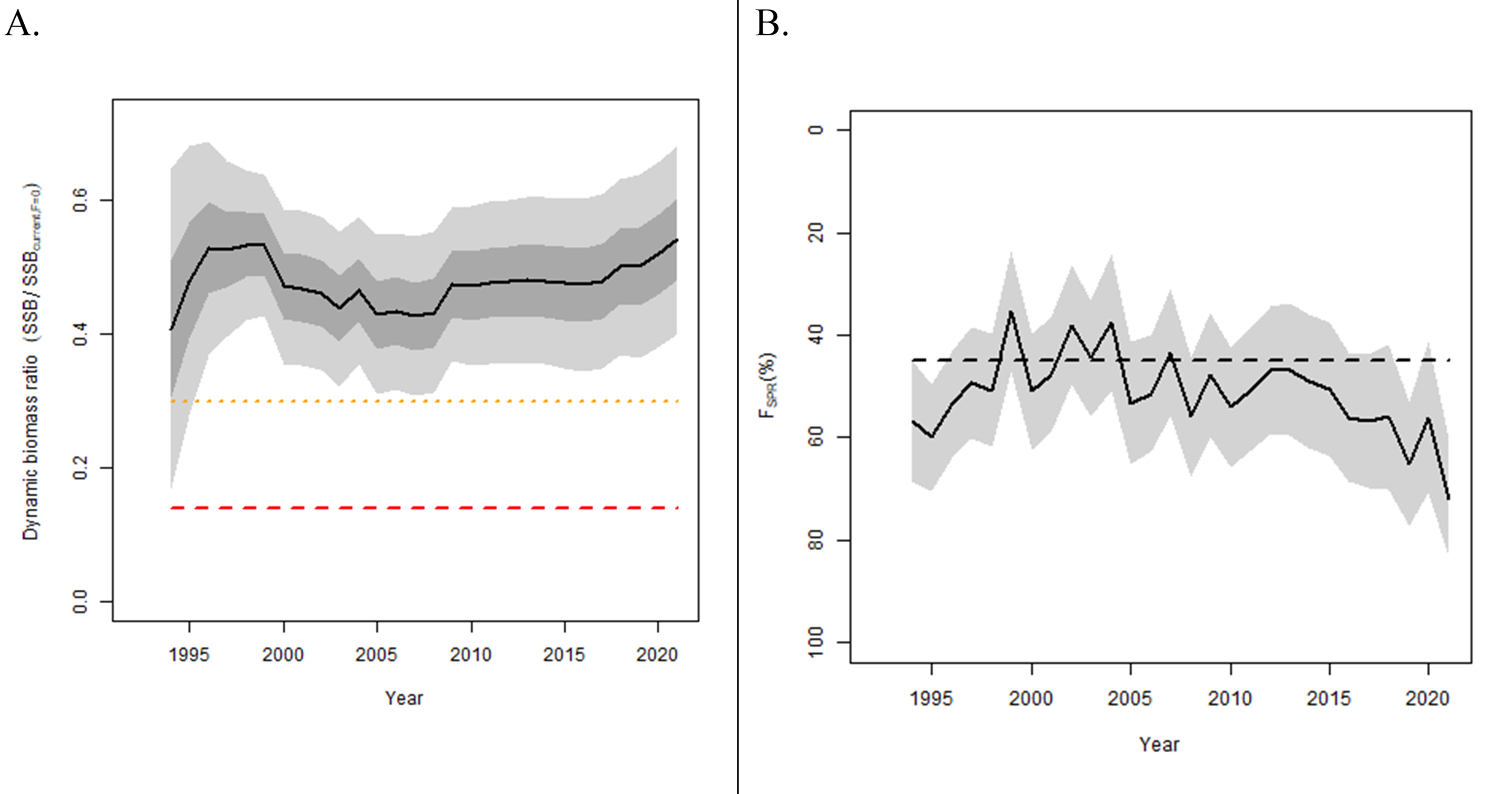Stock Status and Conservation Information
(From ISC24 Plenary Report)
Albacore
![]() Click here to see the ISC23 stock status and conservation information.
Click here to see the ISC23 stock status and conservation information.
Stock Status
Estimated summary biomass (males and females at age-1+) declined at the beginning of the time series until 2004. Subsequently, the summary biomass fluctuated without a trend until 2018, after which the biomass rapidly increased to historically high levels. It should be noted that the high summary biomass estimates during 2018-2021 were highly uncertain and should be treated with caution. These high summary biomass estimates were due to historically high recruitment estimates in 2017 (~433 million fish; 95% CI: 194 – 671 million fish). However, recruitment estimates in the last 5 years (2017-2021) were highly uncertain and should be treated with caution. Estimated female SSB exhibited a similar population trend to the summary biomass, albeit with a lag of several years, and showed an initial decline until 2007 followed by fluctuations without a clear trend through 2021.
The average fishing intensity during 2018-2020 was estimated to be F59%SPR (95% CI: F72%SPR – F46%SPR), which was relatively moderate and resulted in a population with an SPR of approximately 59%. Instantaneous fishing mortality at age (F-at-age) was similar in both sexes through age-5, peaking at age-4 and declining to a low at age-6, after which males experienced higher F-at-age than females up to age 12. Juvenile albacore aged 2 to 4 years comprised approximately 64% of the annual catch-at-age in numbers between 1994 and 2021 due to the larger impact of surface fisheries (primarily troll, pole-and-line), which remove juvenile fish, relative to longline fisheries, which primarily remove adult fish.
Stock status is depicted in relation to the target (F45%SPR), threshold (30%SSBcurrent, F=0), and limit (14%SSBcurrent, F=0) reference points. The estimated female SSB has never fallen below the threshold and limit reference points since 1994, albeit with large uncertainty in the terminal year (2021) estimates. However, the estimated fishing intensity for 5 years (1999, 2002, 2003, 2004, and 2007) exceeded the target reference point. Even when alternative hypotheses about key model uncertainties such as growth were evaluated, the point estimate of female SSB in 2021 (SSB2021) did not fall below the threshold and limit reference points, although the risk increases with the more extreme assumption. In contrast, estimated average fishing intensity during 2018-2020 (F2018-2020) did exceed the target reference point under one of these alternative hypotheses but did not exceed the average fishing intensity during the 2002-2004 period.
The SSB2021 was estimated to be approximately 54% (95% CI: 40 – 68%) of SSBcurrent, F=0 and 1.8 (95% CI: 1.3 – 2.3) times greater than the estimated threshold reference point (Figure 1; Table 1). The estimated current fishing intensity (F2018-2020) was estimated to be F59%SPR (95% CI: F72%SPR – F46%SPR) and was lower than both the F45%SPR target reference point and the average fishing intensity during the 2002-2004 period.


Based on these findings, the following information on the status of the NPO ALB stock is provided by the ISC24 Plenary:
- The stock is likely not overfished relative to the threshold (30%SSBcurrent, F=0) and limit (14%SSBcurrent, F=0) reference points adopted in the WCPFC and IATTC harvest strategies (WCPFC Harvest Strategy 2023-01; IATTC Resolution C-23-02);
- The stock is likely not experiencing overfishing relative to the adopted target reference point (F45%SPR), which is the fishing intensity that results in the stock producing a SPR of approximately 45%; and
- Current fishing intensity (F2018-2020) is lower than the average fishing intensity from the 2002-2004 period (the reference level for IATTC Resolution C-05-02 and WCPFC CMM 2019-03).
Conservation Information
Two harvest scenarios were projected to evaluate impacts on the management objectives of the IATTC and WCPFC for this stock: 1) maintain SSB above the limit reference point, with a probability of at least 80% over the next 10 years; 2) maintain depletion of total biomass around the historical (2006-2015) average depletion over the next 10 years; and 3) maintain fishing intensity at or below the target reference point with a probability of at least 50% over the next 10 years (WCPFC HS 2023-01; IATTC Resolution C-23-02). As a larger cohort is estimated in the latest period of the assessment, all projections show a steep increase of SSB in the first year.
The constant fishing intensity scenario showed that the current fishing intensity (F2018-2020) is expected to result in female SSB increasing to 90,098 t (95% CI: 23,218 – 156,978 t) by 2031. Over the next 10 years, there was: 1) a 97.7% probability of the female SSB remaining above the 14%SSBcurrent, F=0 LRP for all 10 years; 2) a 72.0% probability of the total biomass (age-1+) being above the average of 2006-2015 for any year; and 3) a 95.5% probability of the fishing intensity remaining at or below the F45%SPR TRP for any year.
The constant fishing intensity scenario showed that the current fishing intensity (F2018-2020) is expected to result in female SSB increasing to 90,098 t (95% CI: 23,218 – 156,978 t) by 2031. Over the next 10 years, there was: 1) a 97.7% probability of the female SSB remaining above the 14%SSBcurrent, F=0 LRP for all 10 years; 2) a 72.0% probability of the total biomass (age-1+) being above the average of 2006-2015 for any year; and 3) a 95.5% probability of the fishing intensity remaining at or below the F45%SPR TRP for any year.
Based on these findings, the following conservation information is provided by the ISC24 Plenary for the NPO ALB stock:
- If fishing intensity over the next 10 years is maintained at the current fishing intensity (F2018-2020), then female SSB is expected to remain around 54%SSBcurrent,F=0 (90,098 t), with a 97.7% probability that female SSB will remain above the 14%SSBcurrent, F=0 LRP for all 10 years and the harvest strategy management objectives of the IATTC and WCPFC (IATTC Resolution C-23-02; WCPFC Harvest Strategy 2023-01) will likely be met; and
- If fishing intensity over the next 10 years is similar to the 2005 – 2019 period, then female SSB is expected to decrease to 52%SSBcurrent, F=0 (87,669 t), with a 98.1 % probability that female SSB will remain above the 14%SSBcurrent, F=0 LRP for all 10 years and the harvest strategy management objectives of the IATTC and WCPFC (IATTC Resolution C-23-02; WCPFC Harvest Strategy 2023-01) will likely be met.